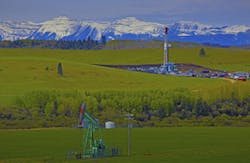Oil sands development not polluting Athabasca Delta, sampling shows
Water pollution is among the many environmental concerns people have about the development of Canada's oil sands. Rivers are routinely monitored for pollution upstream and downstream of a pollution source, but to fully understand the impact of any activity it's important to know the pre-industrial contaminant levels.
This can be tricky to establish in an area like the Athabasca oil sands, where erosion of bitumen-rich riverbanks naturally releases substantial quantities of polycyclic aromatic hydrocarbons and metals into the river.
But now scientists at the University of Waterloo and Wilfrid Laurier University have come up with a way to accurately determine the pre-industrial baseline levels of metals in river sediment downstream of Alberta's oil sands development. Armed with this data, regulators can determine if routine monitoring programs show evidence of man-made pollution.
The new methodology can be applied to any river where insufficient pre-disturbance reference data makes it hard to determine if industrial activities are polluting downstream ecosystems, according to Johan Wiklund, lead author of the study and postdoctoral researcher in the Department of Biology at the University of Waterloo.
The researchers measured eight priority metals, including nickel, vanadium and zinc, in sediments taken from floodplain lakes in the Athabasca Delta that were supplied by river floodwaters before the industrial era (1700-1920).
They normalized their data to lithium concentrations to adjust for confounding differences caused by variations in river flow and sediment grain size. This natural baseline was then compared to metal concentrations measured by the oil sands monitoring organization RAMP (Regional Aquatics Monitoring Program) in sediments collected along the Athabasca River between 2010 and 2013.
Results showed that emissions from the Alberta oil sands and other human activities have not yet increased the concentrations travelling to the Athabasca Delta, around 200 kilometers (124 miles) from the oil sands.
The findings of the study have been published in the peer-reviewed scientific journal Environmental Research Letters.
